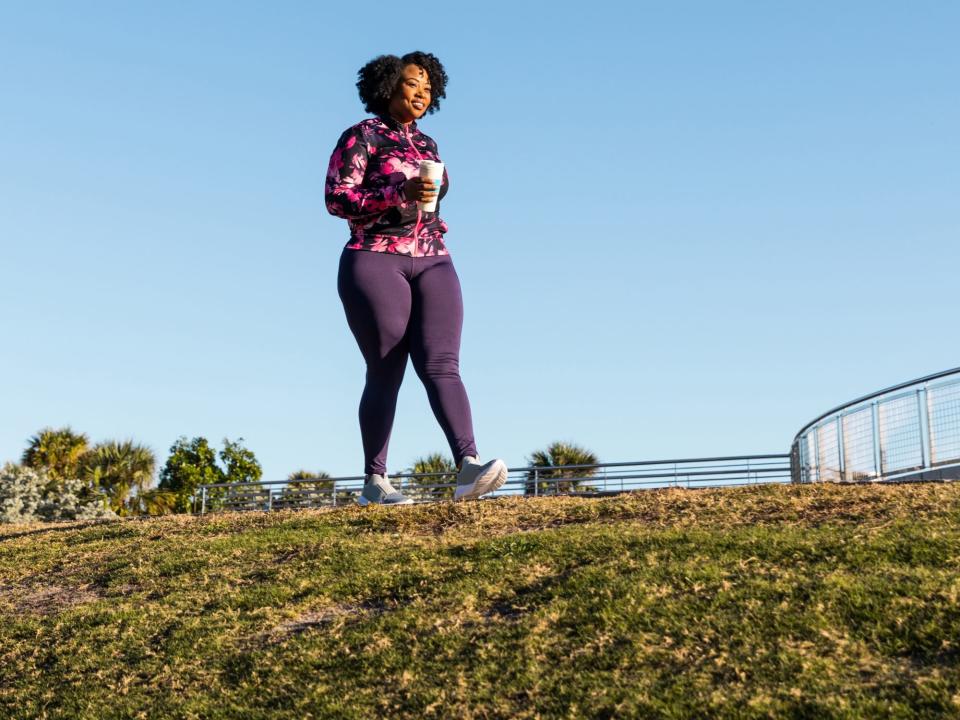7 Easy Ways to Get More Out of Your Walks
Walking remains the most popular fitness activity for good reason: Not only is it accessible, but you also reap a laundry list of rewards. "Walking improves your psychological and physical health," says Patricia Friberg, MPS, a nationally board-certified health and wellness coach in Los Angeles.
For starters, walking is a low-impact activity, which means it will create less stress and strain on your joints, says Samantha Parker, MS, a certified yoga therapist and kinesiophobia and cognitive movement specialist in Washington, D.C. In terms of health, walking can help you lose weight and prevent a wide array of chronic issues, including heart disease, stroke, type 2 diabetes, and certain types of cancers, Friberg says.
It can also improve your mood—especially if you walk outside—and decrease symptoms of anxiety, depression, and stress. After walking, you might also find that you're more creative, focused, and productive. And if you're walking outside, you may even have a stronger connection with your community, or at the very least, your neighborhood, she adds.
Most studies show that the health benefits are attained by taking a brisk walk to the point where your breathing becomes stronger and you start working up a sweat.
Below, fitness experts offer simple strategies for not only making walks more fun but also for engaging your mind and body. Get outside and walk!

Getty Images
Walk with intention
Every week, write down your weekly walking schedule. "Having a plan and intention will help you achieve your goals," Friberg says.
For instance, Monday you might do an interval walk; Tuesday could be a light walk with a friend; Wednesday might be a steady-state walk for 45 minutes; while Thursday you could practice mindful walking by shifting your attention to the external.
A walk can be as short as 15 minutes and merely involve taking in your surroundings in a way that you focus on what you're seeing, smelling, and touching. As you do this, take a few breaths to center yourself. "Awe and walking produce happy hormones, so when you put them together, you get a double boost," she says. Close out the week on Friday with a music walk where you match your pace to the beat of the music.
RELATED: How to Be a Mindful Runner and Practice More Mindful Running
Climb hills
Just as you don't want to do the same exact workout every day, you don't want to walk the same exact route, especially if there aren't any hills. "Adjusting your walking gradient will increase your calorie burn and push you to get more posterior chain (aka your glutes) work out of your walking routine," says Samantha Clayton, former Olympic sprinter and fitness trainer in Los Angeles.
If you're walking outside, change your route so you hit hills from time to time. On a treadmill? Increase the incline, adding more as you see fit, and for a bonus, work to keep the speed consistent as the hills get steeper. Not only will you give your heart a workout, you'll get strength and muscle-building benefits, too.
Enlist a buddy
This should go without saying, but a walking workout with an element of fun will make it easier to stick with longterm. "The best way to have adherence to exercise is to create a positive response to the activity so you want to do it more," Friberg says.
One of the best ways to infuse fun into your workout? Get a buddy. Friberg suggests meeting a friend for regular walks, or if that's not possible, give your bestie a call and walk as you talk.
Incorporate interval training
Interval training, where you alternate between harder and easier periods of work, doesn't only keep you from getting bored, it also works your body more and harder, but in less time, Clayton says.
For instance, try walking fast so that it feels like 7 on a scale of 1 to 10 (10 being an all-out sprint) for 45 seconds and then walk slowly at an effort level of 3 out of 10 for 30 seconds, repeating this your entire walk. You'll improve both your cardiovascular fitness and endurance.
RELATED: You Can Do This Stairs Workout in 15 Minutes—at Home
Time yourself—and beat yourself
Have a favorite loop or walking trail? Time yourself and see if you can walk that loop or trail faster each time, Friberg suggests. Try to beat your time by 15 seconds, then 30 seconds, and keep challenging yourself.
Plan your music in advance
Studies show that music can be a great motivator, especially when it comes to exercising. Put technology to work and create playlists to get a specific response from your body, Clayton says. Go through your music collection and select songs that match the type of workout you want to complete. Steady beats are great for endurance workouts while you might want more powerful music for doing intervals.
RELATED: These 9 Podcasts Will Keep You Thoroughly Engrossed on Your Next Walk
Take to the trails
Trails often have uneven terrain, which comes with surprising benefits. "This forces your mind to become aware of your surroundings and enhances spatial and vestibular awareness needed for balance," Parker says. Plus, the uneven terrain will help you burn more calories and strengthen stabilizer muscles, smaller muscles that often get overlooked.

 Yahoo Movies
Yahoo Movies 
